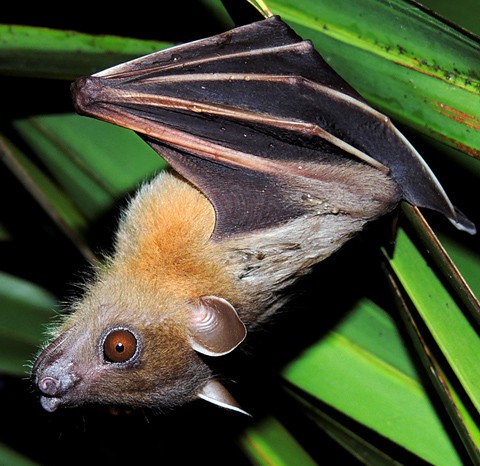Greater short-nosed fruit bat
A species of Short-nosed fruit bats Scientific name : Cynopterus sphinx Genus : Short-nosed fruit bats
Greater short-nosed fruit bat, A species of Short-nosed fruit bats
Scientific name: Cynopterus sphinx
Genus: Short-nosed fruit bats
Content
Description General Info
 Photo By Shantanu Kuveskar , used under CC-BY-SA-4.0 /Cropped and compressed from original
Photo By Shantanu Kuveskar , used under CC-BY-SA-4.0 /Cropped and compressed from original Description
These bats have a relatively long snout. Their upper parts are brown to grey-brown with paler under parts. The fur is very fine and silky. The ears and wing bones of C. sphinx are edged in white. Lower cheek teeth rounded without accessory cusps. The wingspan of the adult is about 48 cm. Juveniles are lighter than adults. Average forearm length is 70.2 mm (64–79 mm). 
General Info
Lifespan
10 years
Diet
Greater short-nosed fruit bat primarily subsists on a fruity diet, particularly figs and guavas. This species showcases a preferential choice towards ripe and fallen fruits, supplementing its diet with nectar and pollen for additional nourishment.
Appearance
The greater short-nosed fruit bat is a medium-sized bat with a robust physique and soft, dense fur. Its body is dominantly brown with a lighter underbelly shade. It possesses a striking wide face structure with large, semi-transparent ears. The greater short-nosed fruit bat boasts extensive wings and a short tail, both membrane-like in texture. Sexually dimorphic, males have a dark collar of fur distinctively absent in females. This species does not demonstrate major changes in appearance with age.
Behavior
The greater short-nosed fruit bat is gregarious, and typically roosts in same-sex groups of eight to nine individuals. The sexes remain separate until the mating season, when group size increases. They are polygynous and 6-10 males and 10-15 females usually share palm-frond tents during the breeding season. It is the only nonprimate species known to show fellatio, which enhances copulation time in the species. Copulation by males is dorsoventral and the females lick the shaft or the base of the male's penis, but not the glans which has already penetrated the vagina. While the females do this, the penis is not withdrawn and research has shown a positive relationship between length of the time that the penis is licked and the duration of copulation. Postcopulation genital grooming has also been observed. Males stay with females for some time after mating, but later return to same-sex groups. The adult sex ratio is very female biased. Researchers attribute this to the relatively rapid maturation of females compared to males. In Central India, C. sphinx breeds twice per year. Females produce a single young at a time. Each half of the bicornate uterus functions during alternate breeding cycles. The first pregnancy cycle occurs from October through February/March. Mating occurs immediately post partum, and a second offspring is born in July. Gestation period is about 3–5 months. In 72% of bats, the first pregnancy occurs in the right horn of the uterus. The corpus luteum in the right ovary persists for some time after the pregnancy and prevents ovulation from occurring in the right ovary during the second breeding cycle. This creates the pattern of alternate functioning of the two horns of the uterus. However, the corpus luteum in the left ovary does not persist until the beginning of the next breeding cycle. As yet, no reason has been found for the dominance of the right horn during the first breeding cycle. Newborn bats weigh about 13.5 g and have a wingspan of 24 cm. By the time of weaning at 4 weeks of age, young bats weigh 25 g and have wings spanning 36 cm. Female short-nosed fruit bats reach sexual maturity at 5–6 months of age, but males are not capable of breeding until they are a year old. These bats are frugivorous, and locate their preferred food items by scent. They have been described as voracious feeders, eating more than their body weight in food in one sitting. Some preferred fruits include ripe guava, banana, chikoo, dates, and lychees. Short-nosed fruit bats inflict serious damage on many fruit crops, and are considered pests. In addition, these bats are possible vectors for Japanese encephalitis, which is serious disease in humans. These bats are important dispersers of date palm seeds, and pollinate many night blooming flowers. They are also know to construct shelter tents by severing leaves and stems from certain creepers and mast trees like Polyalthia longifolia. Frugivory, nectarivory, and folivory are well understood; in addition, geophagy behaviour has also been reported in this species recently, and is suggested to represent an ‘adaptive behavioural plasticity’ in the foraging behaviour of the greater short-nosed fruit bat. According to Mahandran et al. geophagy have the function of mineral supplementation and/or detoxification. 
Population
Increasing
Scientific Classification
Phylum
Chordates Class
Mammals Order
Bats Family
Megabats Genus
Short-nosed fruit bats Species
Greater short-nosed fruit bat